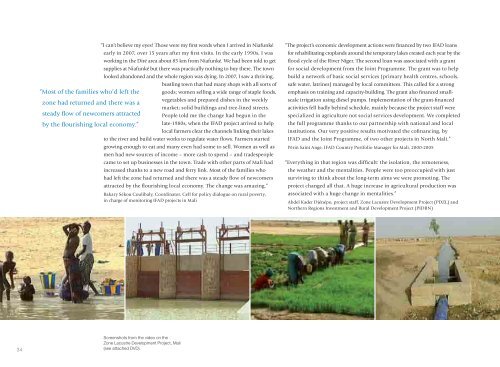Create successful ePaper yourself
Turn your PDF publications into a flip-book with our unique Google optimized e-Paper software.
“I can’t believe my eyes! Those were my first words when I arrived in Niafunké<br />
early in 2007, over 15 <strong>years</strong> after my first visits. In the early 1990s, I was<br />
working in the Diré area about 85 km from Niafunké. We had been told to get<br />
supplies at Niafunké but there was practically nothing to buy there. The town<br />
looked abandoned and the whole region was dying. In 2007, I saw a thriving,<br />
bustling town that had many shops with all sorts of<br />
“Most of the families who’d left the goods; women selling a wide range of staple foods,<br />
vegetables and prepared dishes in the weekly<br />
zone had returned and there was a<br />
market; solid buildings and tree-lined streets.<br />
steady flow of newcomers attracted People told me the change had begun in the<br />
by the flourishing local economy.” late-1980s, when the <strong>IFAD</strong> project arrived to help<br />
local farmers clear the channels linking their lakes<br />
to the river and build water works to regulate water flows. Farmers started<br />
growing enough to eat and many even had some to sell. Women as well as<br />
men had new sources of income – more cash to spend – and tradespeople<br />
came to set up businesses in the town. Trade with other parts of Mali had<br />
increased thanks to a new road and ferry link. Most of the families who<br />
had left the zone had returned and there was a steady flow of newcomers<br />
attracted by the flourishing local economy. The change was amazing.“<br />
Bakary Sékou Coulibaly, Coordinator, Cell <strong>for</strong> policy dialogue on rural poverty,<br />
in charge of monitoring <strong>IFAD</strong> projects in Mali<br />
“The project’s economic development actions were financed by two <strong>IFAD</strong> loans<br />
<strong>for</strong> rehabilitating croplands around the temporary lakes created each year by the<br />
flood cycle of the River Niger. The second loan was associated with a grant<br />
<strong>for</strong> social development from the Joint Programme. The grant was to help<br />
build a network of basic social services (primary health centres, schools,<br />
safe water, latrines) managed by local committees. This called <strong>for</strong> a strong<br />
emphasis on training and capacity-building. The grant also financed smallscale<br />
irrigation using diesel pumps. Implementation of the grant-financed<br />
activities fell badly behind schedule, mainly because the project staff were<br />
specialized in agriculture not social services development. We completed<br />
the full programme thanks to our partnership with national and local<br />
institutions. Our very positive results motivated the cofinancing, by<br />
<strong>IFAD</strong> and the Joint Programme, of two other projects in North Mali.”<br />
Périn Saint Ange, <strong>IFAD</strong> Country Portfolio Manager <strong>for</strong> Mali, 2000-2005<br />
“Everything in that region was difficult: the isolation, the remoteness,<br />
the weather and the mentalities. People were too preoccupied with just<br />
surviving to think about the long-term aims we were promoting. The<br />
project changed all that. A huge increase in agricultural production was<br />
associated with a huge change in mentalities.”<br />
Abdel Kader Djénépo, project staff, Zone Lacustre Development Project (PDZL) and<br />
Northern Regions Investment and Rural Development Project (PIDRN)<br />
34<br />
Screenshots from the video on the<br />
Zone Lacustre Development Project, Mali<br />
(see attached DVD).

















